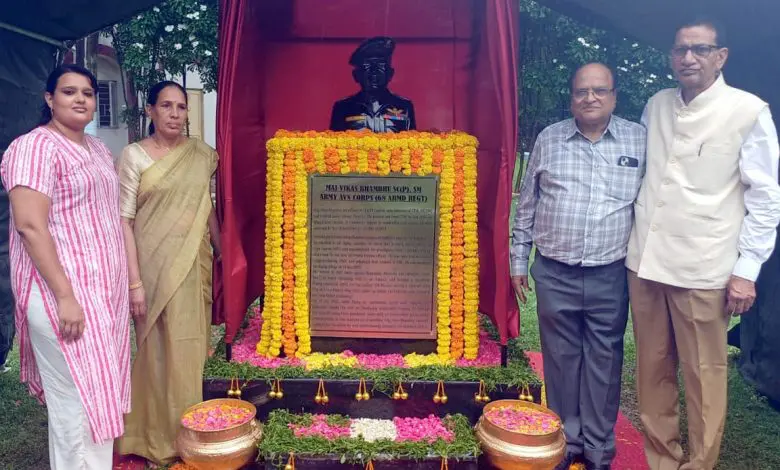Hyderabad, A statue of martyr Major Vikas Bhambhu was installed at the Engineering College of Secunderabad Military Training Base during the Silver Jubilee Celebration 2025. According to a press release issued today, Major Vikas Bhambhu sacrificed his life while serving in Arunachal Pradesh. Originally from the village of Rampura, also known as Ramsara, in Hanumangarh district, his martyrdom is seen as an inspiration in both military and educational fields.
Martyr Major Vikas Bhambhu received his military training at the Engineering College of Secunderabad (Hyderabad) Military Training Base. During this time, he excelled academically and earned top honors at the college. Today, the Silver Jubilee Celebration 2025 was held, where outstanding students were recognized.
Also Read:
As part of the event, the institution honored martyr Major Vikas Bhambhu by installing his statue in Secunderabad (Hyderabad). Senior military officers, including Lieutenant General Neeraj Beswani and Major General Kapoor, along with other officers, unveiled the statue to pay tribute to his sacrifice. The martyr’s father, Bhagirath Bhambhu, and mother, Sukhwanti Devi, were also present at the ceremony to receive the honors.
Engineering College of Secunderabad Military Training Base
The Engineering College of Secunderabad Military Training Base is an institution dedicated to training military personnel in engineering and technical disciplines. Established during the British colonial era in India, it has played a key role in preparing engineers for defense and infrastructure projects. Today, it continues to support the Indian Armed Forces with advanced technical education and specialized military engineering training.
Secunderabad Military Training Base
The Secunderabad Military Training Base, located in Telangana, India, is a key training facility for the Indian Armed Forces. Established during British colonial rule, it has played a significant role in preparing soldiers for both historical and modern military operations. Today, it remains an important center for military education and discipline.
Arunachal Pradesh
Arunachal Pradesh, located in northeastern India, is a culturally rich and biodiverse region known as the “Land of the Dawn-Lit Mountains.” It is home to numerous indigenous tribes, each with unique traditions, and has a history tied to Tibetan and Burmese influences. The region became a full-fledged Indian state in 1987, though its borders remain a subject of dispute with China.
village of Rampura
The village of Rampura, located in India, is a traditional rural settlement known for its rich cultural heritage and agrarian lifestyle. Historically, it has been part of the larger socio-economic fabric of the region, with roots tracing back to medieval times when it served as a small farming community. Today, Rampura retains its rustic charm, offering insights into traditional Indian village life, crafts, and festivals.
Ramsara
There is limited widely known historical or cultural information available about “Ramsara,” and it may refer to a lesser-known site, a misspelling, or a fictional location. If you meant a specific place like Ramsar (a city in Iran known for its wetlands and the Ramsar Convention), please clarify. Alternatively, if Ramsara is a personal or local reference, additional context would help provide a more accurate summary. Let me know how you’d like to proceed!
Hanumangarh district
Hanumangarh district, located in Rajasthan, India, is a historically significant region known for its ancient roots and cultural heritage. It was originally called *Bhatner* and is home to the historic Bhatner Fort, believed to have been established by the Bhati Rajputs around 300 AD. The district was renamed Hanumangarh in the 20th century after the fort was captured on a Tuesday (*Hanuman Jayanti*), a day associated with Lord Hanuman. Today, it is an agricultural hub with rich archaeological sites and religious importance.
Secunderabad
Secunderabad, often called the “twin city” of Hyderabad, was established in 1806 as a British cantonment (military base) during the colonial era. Named after Sikandar Jah, the third Nizam of Hyderabad, it became a key military and trading hub. Today, it is a bustling urban center known for its colonial-era architecture, vibrant markets, and cultural diversity.
Hyderabad
Hyderabad, the capital of India’s Telangana state, is a historic city founded in 1591 by Muhammad Quli Qutb Shah. Known for its rich cultural heritage, it boasts iconic landmarks like the Charminar and Golconda Fort, reflecting its blend of Mughal and Persian influences. Today, Hyderabad is a major tech hub, often called “Cyberabad,” while preserving its traditional cuisine, including the famous Hyderabadi biryani.






